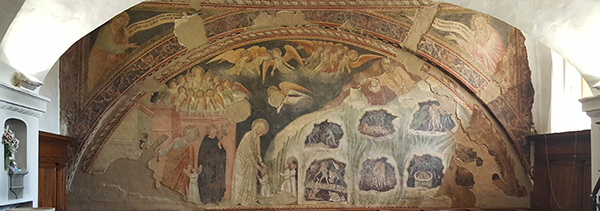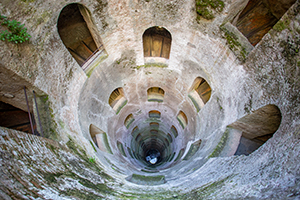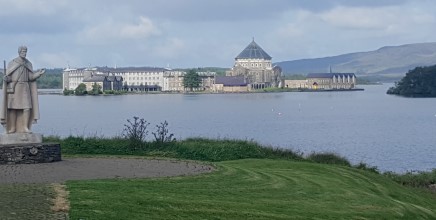St Patrick in Italy
Published in Features, Issue 2 (March/April 2021), Volume 29The fresco of St Patrick’s Purgatory and ‘St Patrick’s Well’ in Umbria
By Brenda Moore-McCann
“It is probably the first, the largest and the most complex artistic representation of Purgatory and the St Patrick legend in existence.”
In 1998, while on an art history research trip to Italy, I came across a spectacular sixteenth-century well dedicated to St Patrick in Orvieto, Umbria. A few years later, I discovered to my surprise that there was a fourteenth-century fresco in the Umbrian town of Todi also dedicated to St Patrick. How was it that Ireland’s patron saint was so well known in Italy that he merited such dedications?
The legend
The answer lies in the fifth-century legend in which Patrick complained to God that the pagan Irish were not listening to his sermons about the afterlife, Heaven and Hell. He was told to go to Station Island in Lough Derg (Red Lake), Co. Donegal. There he would find a pit in the ground within which he could see souls in Purgatory atoning for their sins while submitting to a variety of punishments. If deemed sufficiently contrite and purified, they could then proceed to Heaven. This oral legend was eventually written down by the Cistercian monk Henry of Saltrey between 1170 and 1185, and was subsequently widely translated throughout Europe, including Italy. In Henry’s account, the Irish knight Owein, who wanted to repent of his wayward life, entered the Underworld, where he witnessed the pains and torments of souls in Purgatory before exiting to live a reformed life, then dying and arriving in Paradise. In the Italian version the errant knight was named Nicholas.
The legend was popularised by the Golden Legend: readings on the saints by Jacobus de Voragine (c. 1260–98), bishop of Genoa. This was the most widely read book, after the Bible, in medieval times. Because of the popularity of the legend, Lough Derg became the only Irish site of pilgrimage from countries such as Italy, Spain and Hungary during the Middle Ages. The practice continued throughout the centuries up to the present day, when up to 11,000 pilgrims per year spend three days in prayer and penitence on Station Island.
The legend also entered contemporary Irish literature with the poems Lough Derg (1942) by Patrick Kavanagh and Station Island (1984) by Seamus Heaney. Heaney had visited Lough Derg many times while a student at Queen’s University, Belfast. His three-part poem, modelled to a degree on the structure of Dante’s Divine Comedy (1308–20), which he had read in the 1970s, presented a mythologised journey involving a rigorous self-examination of the responsibilities of a poet. Along the way he meets the ghostly shades of his cousin, murdered in the Northern Ireland Troubles, and influential literary figures like Kavanagh and James Joyce.
It is worth noting briefly that there were earlier Irish visionary texts involving the journey of a human to the Underworld, which became influential prior to St Patrick’s Purgatory. Indeed, similar myths of the afterlife are found in other Indo-European cultures, such as the Greek myths of Orpheus visiting the Underworld to find his wife Eurydice and of the Elysian Fields of Paradise reserved for Greek heroes. The concern of Irish Christianity for the fate of souls in the afterlife, represented by the purgation of sins in Purgatory, usually conformed to two types: the vision of and the voyage to the Underworld. The journey of St Brendan to find a remote island in the Atlantic where souls rested, for example, was recounted in the Navigatio Sancti Brendani by an Irish writer between the seventh and tenth centuries. It underwent innumerable translations and adaptations into vernacular languages throughout Europe. Medieval geography also continued to mark the mythical island on maps of the Atlantic until the eighteenth century.

St Patrick’s Purgatory/Purgatorio di S. Patrizio (1346), a fresco attributed to Jacopo di Mino del Pellicciaio, in the Servite monastery of San Marco, Todi, Umbria, Italy. (Brenda Moore-McCann)
The idea of Purgatory, which broke the binary of Heaven and Hell with a third ‘in-between’ place, was first given concrete form in the West in Irish literature. The Vision of Fursa (c. 627) recounts the return of the author from the afterlife and the purification of his body with fire. The Vision of Adomnán (c. 1000), which has been called ‘an Irish precursor of Dante’, related a similar journey, in which the writer is guided by a guardian angel through different categories of sinners and the diverse torments meted out to them. In Visio Tundali (c. 1149) an Irish knight, Truthgal, from Cashel in Tipperary, wishing to repent for his sins, had a visionary experience, after which he returned to earth to lead a Christian life. He related his experiences to Marcus, a Benedictine monk at Ratisbon, Germany, who wrote it down. It became popular and was translated into French, German and Italian. The best known of these visionary legends was, however, the Tractus de Purgatorio Sancti Patricii (St Patrick’s Purgatory). Some scholars have suggested that the popularity of the legend was so great that it had an impact on Dante’s Commedia (Divine Comedy), although others dispute this.
St Patrick was not the only source of the Irish legacy in the first millennium. Monks like Columbanus (d. 615) and Donatus (d. 876) were other important channels of Irish influence, together with the stories brought by Irish travellers. Donatus was born on Holy Island/Inis Cealtra, Co. Clare. As bishop of Fiesole (near Florence) he promoted the cult of St Bridget. He donated St Bridget’s Church and hospice in Piacenza to the abbey of St Columbanus of Bobbio in 850 on the condition that hospitality was offered to all Irish travellers. Donatus also wrote a Life of St Bridget and an eleventh-century account of his own life is preserved in the Laurentian Library, Florence. The writings, sermons and letters of Columbanus, who also promoted the cult of St Bridget, are in Bobbio, and a hermitage dedicated to St Bridget is found outside Fiesole. This assimilation of Irish texts into European literature and the popular veneration of Irish saints is clear from the cults and the celebration of their annual feast-days and is evident in dedicated hermitages, churches and wells. The influence of St Patrick in particular, however, is also found in other areas of artistic expression in Italy.
The fresco
The popular belief that there had been a fresco in the Umbrian Servite monastery of San Marco (since 1600 a monastery of the Poor Clares of St Francis) persisted in Todi, a Perugian town on the medieval pilgrimage route to Rome. The wall in the choir of the monastery had been plastered over with limestone during an outbreak of plague in the 1600s, except for the face of Filippo Benizzi, the prior general of the Servite Order from 1267 to 1285. Benizzi had died in the monastery and was canonised in 1671. The strong cult of devotion to Benizzi that continued in Todi led to a commission in 1974 to see whether the fresco existed. The restoration by Marcello Castrichini and Leonilde Dominici between 1974 and 1985 revealed the wonderful fresco of St Patrick’s Purgatory, dated to 1346 and attributed to the Sienese artist Jacopo di Mino del Pellicciaio (pp 18–19). It is probably the first, the largest and the most complex artistic representation of Purgatory and the St Patrick legend in existence. It can be visited only by appointment as the monastery belongs to an enclosed order.
The fresco, called ‘a sermon in paint’ by Noel Mac Tréinfhir (1986), shows the passage of souls from Purgatory to Paradise through the mediation of the Madonna and (then) Blessed Filippo Benizzi, who is placed in a central position beside the Madonna (left of centre). It measures 3.5m by 7.5m, is semicircular in form and contains an almost symmetrical composition of figures around the centrally placed majestic figure of the Madonna, dressed in a white veil and robe adorned with stars. The larger scale of the Madonna compared to the other figures indicates her special position as a mediator between God and man as she greets cleansed souls coming out of Purgatory. Purgatory is represented on the right as a mountain in section within which are two layers of pits, each representing punishments for each of the Seven Deadly Sins: avarice, lust and pride on the upper level, and indolence, wrath, envy and greed below. Above these, on the right, St Patrick, dressed in magnificent robes, bishop’s mitre and halo, is seen showing the knight Nicholas the pits of Purgatory. The left side of the composition is a complete contrast to the dark torments on the right. St Peter, with his key, welcomes souls into the Heavenly City of Jerusalem. Above the city walls, Christ is surrounded by eleven angels, representing the loyal Apostles (without Judas). Another host of angels hovers above, at the centre of the fresco, their wings skilfully adapted to fit under the framing semicircle. Above this are two figures in quadrants with scrolls, directing the viewer’s attention to the scene but also enunciating the fresco’s key themes. Isaiah’s scroll on the right, for example, reads: ‘Comfort, comfort my people, says the Lord your God’ (Isa. 40:1), while Matthew’s on the left reads: ‘Come ye blessed of my Father, enter into the kingdom prepared for you since the foundation of the world’ (Matt. 2:2). This magnificent medieval work of art was complemented by another dedicated to St Patrick, a couple of hundred years later, in the nearby Umbrian town of Orvieto.
The well

Above: The well, constructed in 1527 by Antonio Sangallo in Orvieto, Italy, which later became known as St Patrick’s Well/Pozzo di S. Patrizio. (Patrick Nicholas)
St Patrick’s Well was originally called Pozzo della Rocca because it was situated near the Albornoz military fortress in Orvieto. When the fortress became obsolete, the name of the well gradually changed to become associated with the legend of St Patrick’s Purgatory. While the precise reasons are unclear, some sources allude to the similarity of the deep well to the pit of the legend, while another suggests that the Servite monks of Orvieto in the 1800s renamed it, promising remission of sin in exchange for contributions thrown into the water. This idea of an association between water and purification was far removed from the original practical purpose of the well, which was to supply Orvieto with water. Its historical origins lay in the Sack of Rome in 1527 by the mutinous troops of Charles V, and the escape of Pope Clement VII (Giulio de’Medici) to Orvieto, a few hundred kilometres north of Rome. A nephew of Lorenzo de’Medici, Clement VII was an intellectual, a musician and a patron of the arts who had commissioned Michelangelo’s Last Judgement in the Sistine Chapel, as well as works by Raphael and Bandinelli. He commissioned Antonio Sangallo the Younger to construct a well in case of a prolonged siege of Orvieto. Sangallo’s design became the marvel of engineering still seen today (p. 20). The well is 62m deep and 13m wide. The central cylinder is surrounded by two separate staircases, one descending, the other ascending, each with 248 steps. The staircases were wide enough to allow two mules to carry water containers on their backs without meeting. In spite of its depth, the cylinder is well lit by 72 windows, and at the bottom there is a small bridge suspended over 3m of water. The double-helical staircase is thought to have been inspired by a lost design by Leonardo da Vinci for the Château Chambord in the Loire Valley (da Vinci was in the service of the king of France, Francis I, from 1516 until his death in 1519). The construction of the château began in 1527, the same year as the well.
With the change of its name over time, St Patrick’s Well shifted from its original practical purpose of supplying water to Orvieto to assuming allegorical associations with life itself. The vertical architecture connecting what was below to what was above led to a belief that such structures were the axis of the universe, a link between earth and sky, man and the cosmos. In Christianity this ‘astronomical telescope’ was further interpreted allegorically: if it was possible to see the heavens from the depths of the earth, then it was possible for man to contemplate the divine from the depths of his humanity. The capacity to absorb more and more natural light as one ascended the stairs from the relative darkness below was also seen symbolically. Thus wells in various cultures have had a long association with rites of purification, transformation and renewal. In this case, the legend of St Patrick transformed a once purely functional structure into one of mythology and religion embodying the hope of salvation.

Above: Station Island, Lough Derg. (Brenda Moore-McCann)
Another fascinating aspect of St Patrick’s Well is the geometry of the double-helical staircases and their relationship to such mathematical and related wonders as the Golden Section (called ‘Divine Proportion’ by Kepler) and the Fibonacci sequence of numbers. These have been studied by mathematicians, physicists, musicians and aestheticians for centuries. The helix is a spiral form that curves uniformly around a central core or axis. Intertwined helices, one left-handed and the other right-handed, are found in nature—in the sunflower, for example. Separated helices, like the well, are also right-handed when moving away from and left-handed when moving towards the observer. The double helix, the symbol of medicine since ancient times, was discovered in 1953 to be the underlying structure of our DNA, the basic code of human life, by Watson and Crick (based on the work of Rosalind Franklin). Amazingly, like the sunflower, the structure of DNA is linked to consecutive Fibonacci numbers and the Golden Section. Given the interest in such mathematical relationships on the part of artists in the Renaissance, we can speculate that Sangallo’s well, although constructed for the practical purpose of transporting water, was also designed to appeal aesthetically through the mysterious appeal of numbers and geometry.
Finally, to answer the question posed at the beginning, it seems that Celtic legends, like that of St Patrick, so vividly affected the imagination of early medieval Europe that they established the idea in literature of the vision of, and travel to, the Underworld. These ideas also became expressed in the visual arts in the form of the two outstanding works described here, which we can still see today.
Brenda Moore-McCann is an art historian and Assistant Professor (Adjunct) in Trinity College, Dublin.
FURTHER READING
C. de Petris, ‘St Patrick’s Purgatory—a fresco in Todi, Italy’, Studi Irlandesi 2 (2) (2012).
N. Mac Tréinfhir, ‘The Todi fresco and St Patrick’s Purgatory, Lough Derg’, Clogher Record 12 (2) (1986).
A. Tommasini, Irish saints in Italy (London, 1937).
















